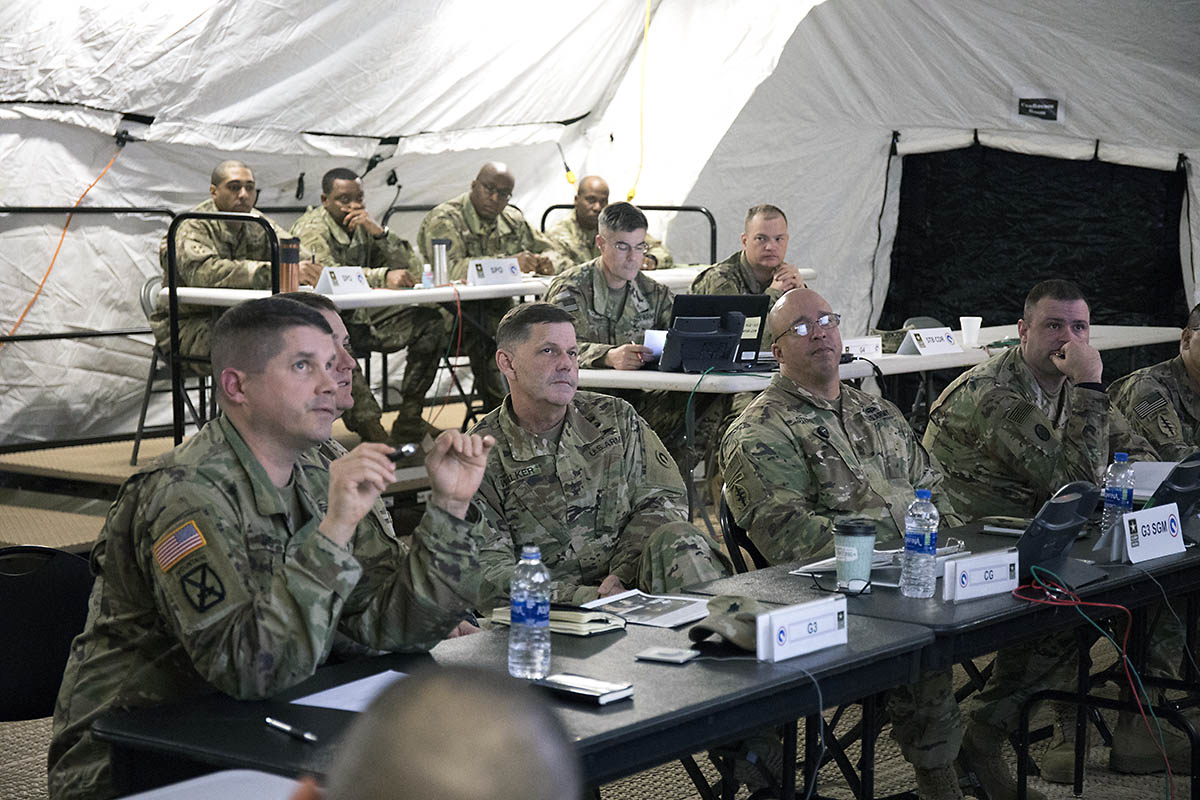Written by Master Sgt. Jonathan Wiley
1st Theater Sustainment Command
 Fort Knox, KY – For the third time in less than 12 months, the 1st Theater Sustainment Command (TSC) conducted a large-scale field training exercise – this time to Fort Campbell, KY February 13th-23rd.
Fort Knox, KY – For the third time in less than 12 months, the 1st Theater Sustainment Command (TSC) conducted a large-scale field training exercise – this time to Fort Campbell, KY February 13th-23rd.
The unit deployed its Early Entry Command Post (EECP), a mobile command post that allows the unit to conduct operational-level sustainment from any location in the world, the creation of which is an initiative began by Major General Flem B. “Donnie” Walker Jr. commanding general, 1st Theater Sustainment Command (TSC), shortly after he assumed command of the unit.

“Eighteen months ago, Major General Walker realized he did not have an expeditionary capability for his headquarters so he began to task the team for developing what that would look like,” said Lt. Col. James Crocker, commander, 1st Special Troops Battalion, 1st Theater Sustainment Command. “Since that time, we have acquired what we need to set up a fully functional expeditionary headquarters, including everything from the generators, the tents, the environment control units, communications equipment, and all of the life support equipment that was not on our MTOE (mission table of equipment).”
Now, the 1st TSC is able to project 500 Soldiers to any austere environment in the world and conduct sustainment operations for an indefinite period of time, Crocker said.
This exercise was the first time the 1st TSC deployed the EECP by air.

“Moving one of our force packages by air substantially increased our deployment time, gave the Soldiers a chance to practice new skills, and developed our relationship with the Air National Guard,” said Command Sgt. Maj. Carey Welsh, senior enlisted advisor, 1st STB, 1st TSC. “We set up in cold, wet conditions versus ideal conditions we had in past rotations and were still able to cut our set up time by 18 hours,” Welsh added.
In order to conduct expeditionary sustainment operations, the 1st TSC requires responsive and scalable tactical communications teams available to deploy on short notice to support them.
The 50th Expeditionary Signal Battalion-Enhanced (ESB-E), 35th Theater Tactical Signal Brigade, provided this support for this exercise.
The 50th ESB-E is a pilot unit the Army stood up in November 2018 to provide alternative tactical network equipment that is smaller, lighter, and more agile and reduces reliance on legacy Warfighter Information Network Tactical (WIN-T) equipment.
Napoli said providing communications to a command post with Tactical Communication Nodes typically requires multiple trucks, trailers, communication shelters, and up to a platoon-sized element of Signal Soldiers. The 50th ESB-E is able to provide the same level of support with a much smaller footprint.
“We can support a battalion-sized TOC (tactical operation center) with just one civilian Sport Utility Vehicle and four Soldiers,” said Sgt. Brian Cobb, medium node team chief, 50th ESB-E.
In addition to bringing out its medium communication node, the 50th ESB-E also brought out a large communication node, Napoli said, which helped determine what Army asset the 1st TSC needs for tactical communication support.
“From this exercise, we have figured out that if we deploy the entire EECP, we need the large communication node,” Napoli said. “If we scale the EECP configuration down, we would probably be better served by the medium.”
During the exercise, Brig. Gen. Robert L. Edmonson II, deputy chief of staff, G-6, U.S. Army Forces Command (FORSCOM), visited the EECP site.
He said providing support for exercises like this one is helping shape future equipment solutions and force structures for tomorrow’s ESBs.
“Right now, with exercises like this one, we are deciding what our kit capabilities are going to look like in the future,” he said.
“We strengthened the 1st TSC’s relationship to FORSCOM, which will make future requests for support easier,” he said. “We can now pick up the phone and call directly up to FORSCOM and give them a heads up about any training events or real-world operations we have coming up and ask them to start the mission analysis as early as possible.”
Napoli also said having a relationship with units like the 50th ESB-E is critical.
“The ideal solution is to have a habitual relationship with a numbered unit like the 50th for support,” he added.
Building on what has learned at Fort Campbell, the 1st TSC is scheduled to deploy a part of the EECP to Jordan to as part of the multinational exercise Eager Lion 2019.



